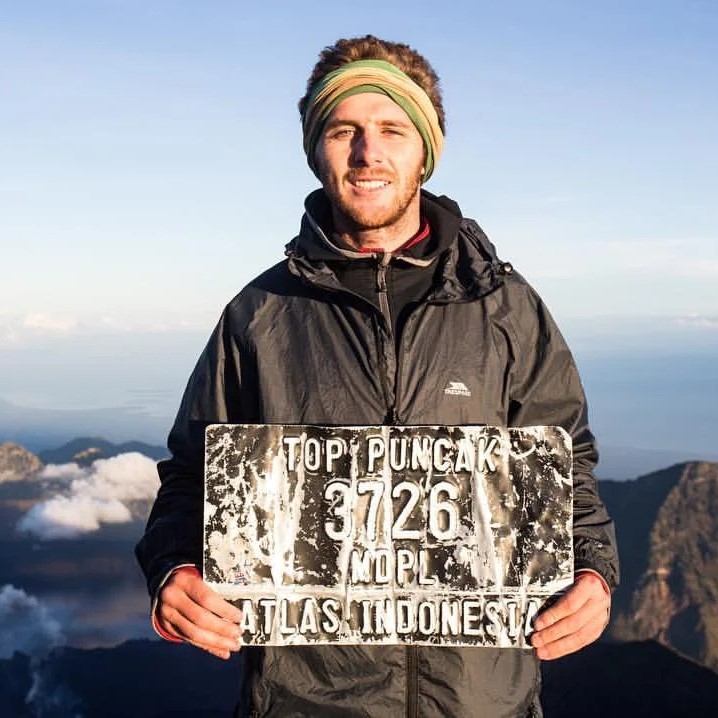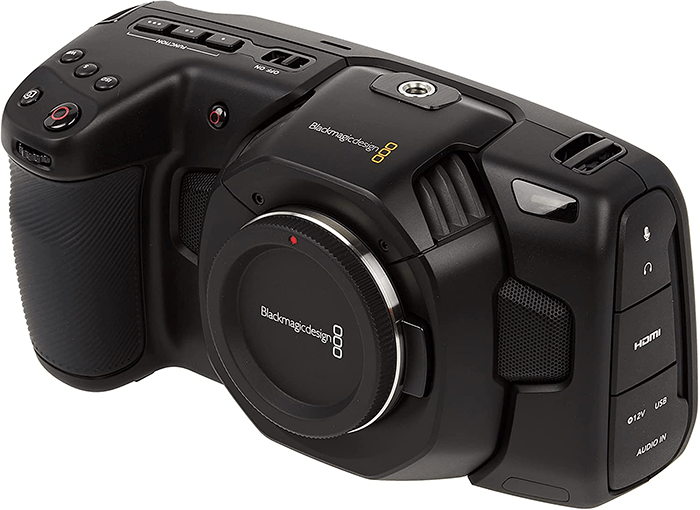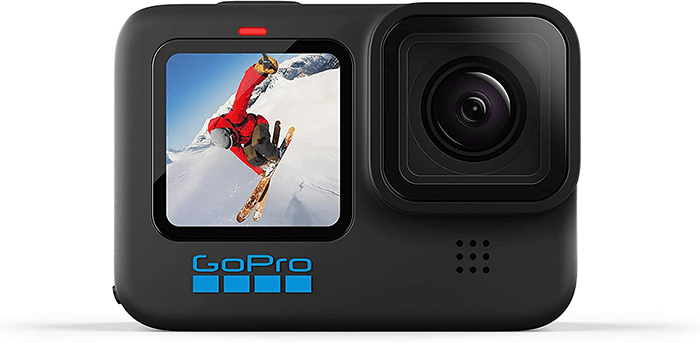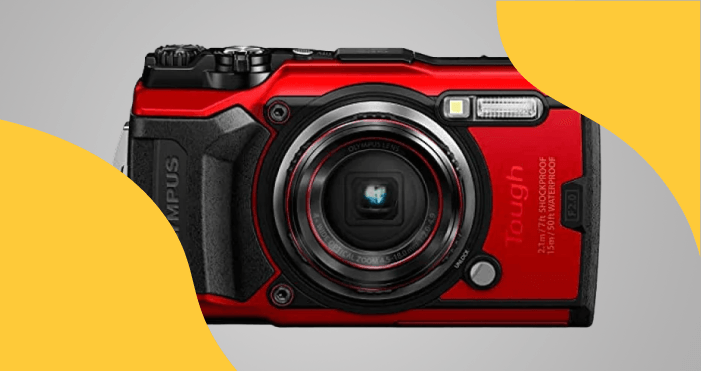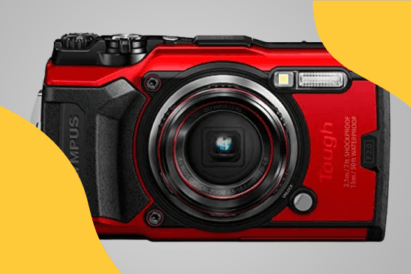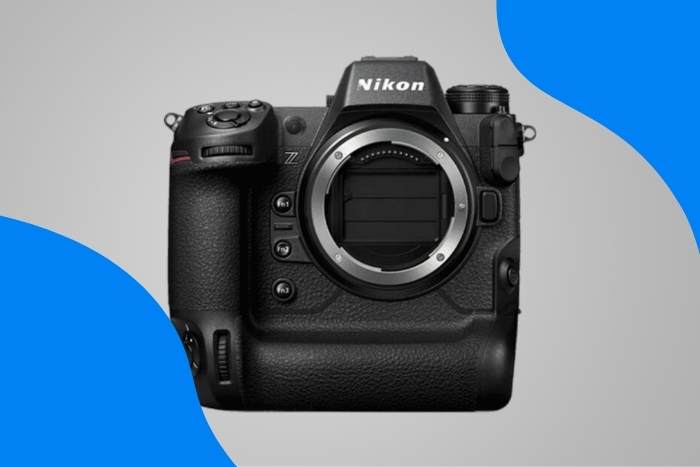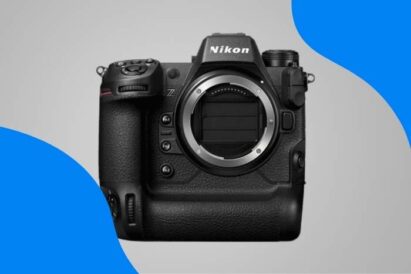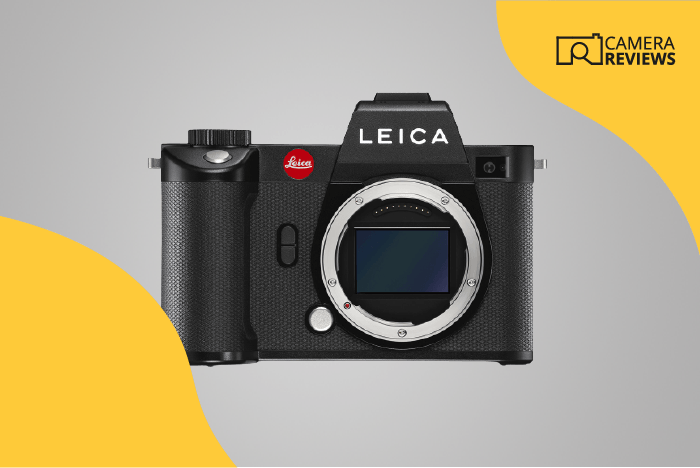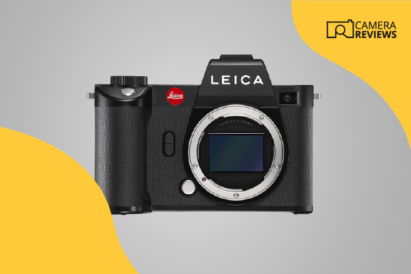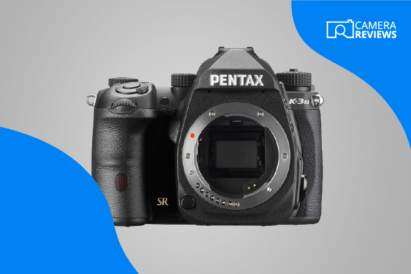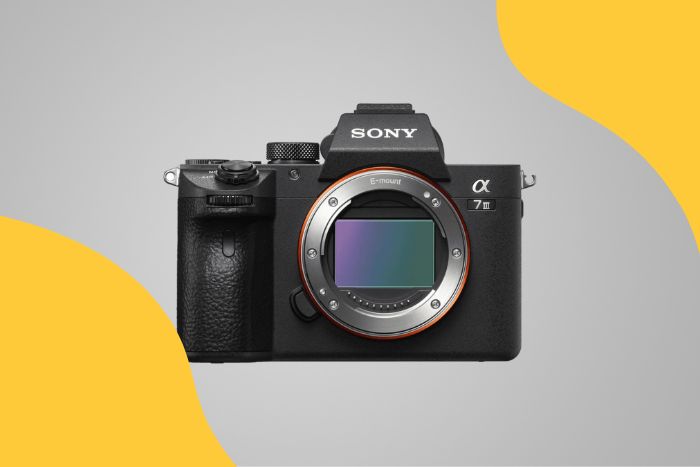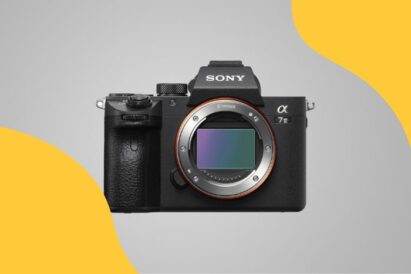Recording in slow-motion is a creative and popular way to spice up your video content. In the past, finding a slow-motion camera was exceedingly difficult. However, today many cameras can capture spectacular slow-motion footage.
There is only one problem with this. How are you supposed to figure out which slow-motion camera is best for you with so many options available?
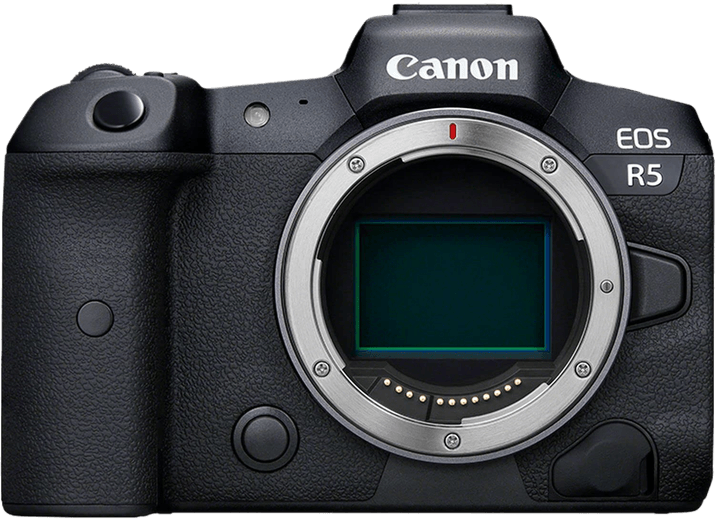
Canon EOS R5
Fantastic 4K/120p slow-motion footage, eye- and face-tracking, and industry-leading image stabilization.
That’s where we come in! After extensive research, we built this comprehensive guide on the best slow-motion cameras.
Whether you want a mirrorless, DSLR, or point-and-shoot camera, many options are below. Also, we have gone out of our way to include a handful of specialty items like action cameras, drones, and even slow-mo phones.
Here’s a brief overview of our top 9 slow-motion cameras.

- Stunning 8K videos
- Impressive 4K/120p slow-motion
- Fantastic image tracking
- Industry-leading image stabilization
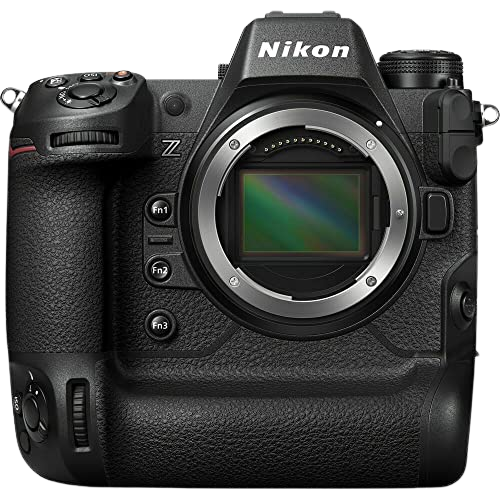
- Extremely fast readout speeds
- Uncropped 4K slow-motion
- Three compression rates improve video quality and storage capabilities
- 8K/60p slow-motion for professionals

- Premier low-light shooting
- Versatile video frame rate options
- S&Q mode for in-camera slow-motion
- Lightweight for travel
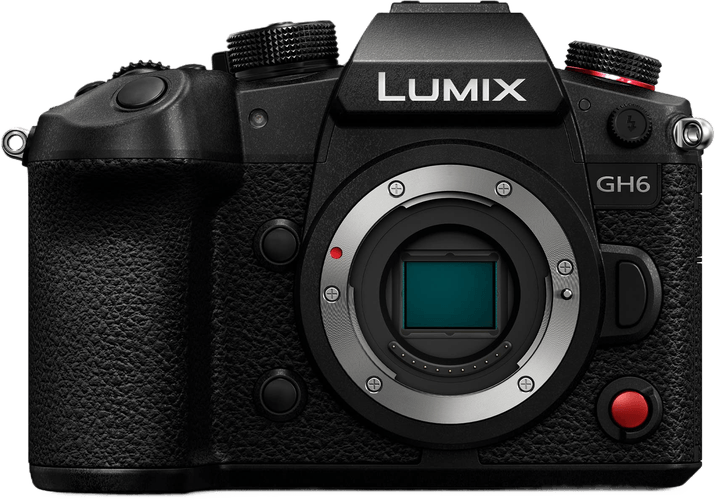
- High-end Micro Four Thirds sensor
- Amazing details in 5.7K/60p slow motion
- One of the best super slow-motion cameras for fast-moving action sports
- internal fan addresses overheating issues
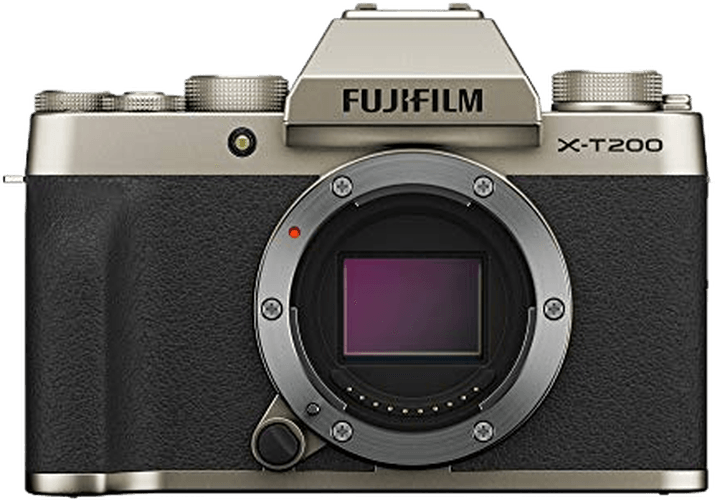
- Portable and compact
- Vibrant colors
- Excellent autofocus for clear videos
- Fully-articulating touchscreen LCD for difficult angles and selfies
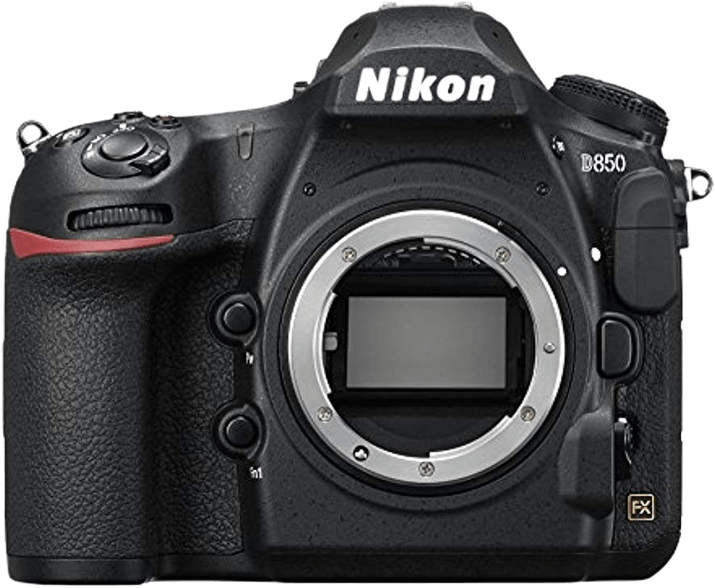
- High-resolution full frame sensor
- 4K video resolution
- Beautiful 120p slow-motion footage
- Built-in intervalometer for mind-blowing time-lapses

- Solid 1080p/120p video
- Spectacular colors
- Great ergonomics
- Intuitive easy-to-use menus
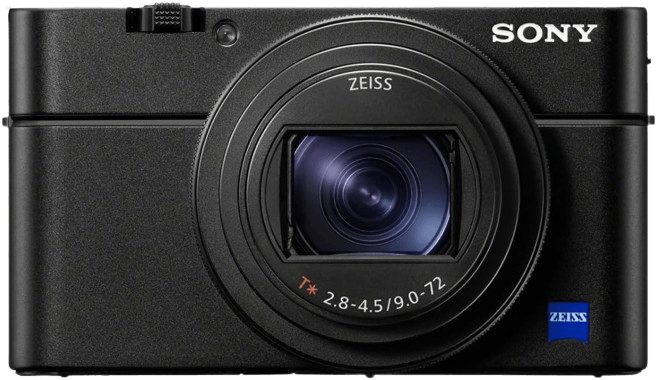
- Ultra-portable camera
- High-quality 24-200mm Zeiss zoom lens
- Stunning slow-motion clips
- Super slow-motion up to 960 fps
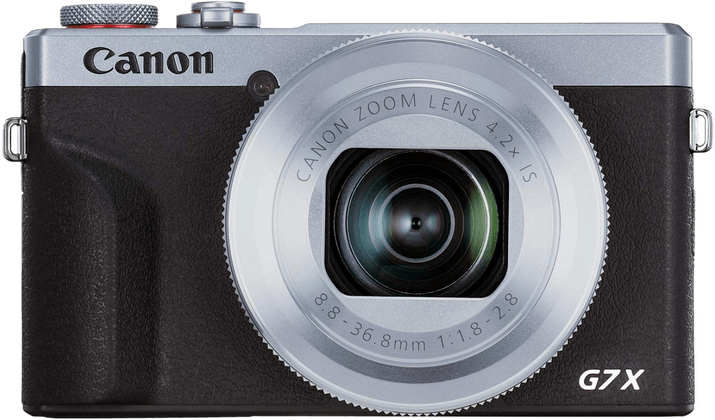
- Versatile 24-100mm zoom lens
- Optical image stabilization helps handheld shooting
- Live streaming to YouTube and Vertical Video perfect for social media
- Flip-up rear touchscreen
What is the Best Camera for Slow Motion?
When choosing a slow-motion camera, here are some of the most important things to consider.
First, the camera needs to be capable of shooting at high frame rates. Slow-mo footage typically is considered anything shot at 60 frames per second (fps) or higher. Once you go over 120 fps, you have what is known as super slow-motion.
While there are no strict rules on when to use specific frame rates, I have found that some work better than others, depending on what you are filming. Here are my recommendations.
60p produces smooth results with little to no motion blur. While not overly slow, it creates a dramatic feel in movies and documentaries. It can easily be slowed down more or sped up in post-production. Moreover, 60p is ideal for B-roll (supplementary material), sports, and gamers.
120p is the standard for slow-mo video and should be your go-to frame rate. It has a cinematic look that filmmakers crave and is perfect for wide-angle, establishing shots. Additionally, it is great for moving subjects like when people or animals are running.
Super slow-motion frame rates are good for things that move faster than the eye can see—running water, flying birds, action sports, balloons popping, explosions, etc.
Other things to think about in slow-motion cameras are, what is the video resolution? Does the camera have in-body image stabilization? What memory card formats does the camera accept, or how much built-in storage does the device have? Plus, does the camera have a flip-up or fully-articulating screen?
How Do I Make My Camera Slow Motion?
Setting up your camera to capture slow-motion video is super easy. There are three simple steps to follow.
- You first need to go into your camera’s custom settings menu and select your desired movie resolution (4K, 1080p, etc.).
- Next, navigate to the recording settings and choose your preferred frame rate. If you don’t see the frame rate you are looking for, you are probably not in the correct resolution.
- Finally, don’t forget to set your shutter speed to double (or as close to double as possible) your frame rate.
Once that’s done, you are ready to start recording your very own epic slow-mo movies!
15 Best Cameras Slow Motion Cameras to Buy
Now, with that out of the way, let’s find out which of these excellent slow-motion cameras will help take your movies to the next level!
1. Canon EOS R5

| Camera Type |
Camera Type
|
| Megapixels |
Megapixels
45 MP |
| Sensor Format |
Sensor Format
|
| Sensor Size |
Sensor Size
23.9 x 35.9 mm
|
| Frame Rate |
Frame Rate
20 fps |
| Autofocus Points |
Autofocus Points
1,053 |
- Large 45 MP sensor
- High frame rate of 20 fps
- In-Body Image Stabilization (IBIS)
- Body, face, eye, and animal tracking
- 8K/30p Ultra HD video
- Expensive
- Complicated autofocus setup
- Noise reduction applied to RAW files
- Hard to customize
- Overheats shooting video
The Canon EOS R5 was released in 2020 and is Canon’s flagship mirrorless camera. Thanks to its powerful Digic X image processor, it can record stunning 8K videos and equally impressive 4K/120p slow-motion footage. The only other Canon camera that matches its video capabilities is its sibling, the Canon EOS R5 C.
The new Dual Pixel II autofocus (AF) system covers 100% of the sensor when shooting slo-mo videos and has fantastic tracking. Furthermore, face- and eye-detection AF works with both humans and animals. This makes it an excellent option for both filmmakers and wildlife videographers.
Another feature that boosts the quality of slow-mo clips is the industry-leading in-body image stabilization (IS). When paired with specific lenses, like the Canon RF 24-70mm f/2.8, it adds eight stops of exposure. So the IS reduces camera shake during handheld shooting and improves low-light performance.
Lastly, the EOS R5 has dual memory card slots. One for CFexpress cards and one for Ultra HS-II SD cards. An important thing to note is that for 4K slow-motion and 8K recording, you need to use a CFexpress card.
2. Nikon Z9

| Camera Type |
Camera Type
|
| Megapixels |
Megapixels
45 MP |
| Sensor Format |
Sensor Format
|
| Sensor Size |
Sensor Size
23.9 x 35.9 mm
|
| Frame Rate |
Frame Rate
20 fps |
| Autofocus Points |
Autofocus Points
1,053 |
- Large 45 MP sensor
- High frame rate of 20 fps
- In-Body Image Stabilization (IBIS)
- Body, face, eye, and animal tracking
- 8K/30p Ultra HD video
- Expensive
- Complicated autofocus setup
- Noise reduction applied to RAW files
- Hard to customize
- Overheats shooting video
The Nikon Z9 was announced in October 2021 and is the newest camera in their professional lineup of full-frame mirrorless cameras. It is a hybrid digital camera with 8K video capabilities, breakneck readout speeds, and 45.7MP still images.
It shoots uncropped 4K slow-motion video at 60, 100, and 120 frames per second. Moreover, you can choose to capture slow motion in three different professional-level codecs—H.264, H.265, and Apple ProRes. These compression rates improve video quality and take up less storage.
For even better resolution, you can record slow-motion at a ridiculous 8K/60p. While the files are massive, it is worth it for professionals, especially if you plan to show your content on the big screen.
Two more features I love are the sensor cover and its large battery. The sensor shield keeps unwanted debris from getting on the sensor when not in use, whereas the battery lets you shoot uninterrupted for longer.
3. Sony Alpha a7S III

| Camera Type |
Camera Type
|
| Megapixels |
Megapixels
12.1 MP |
| Sensor Format |
Sensor Format
|
| Sensor Size |
Sensor Size
23.8 x 35.6 mm
|
| Frame Rate |
Frame Rate
10 fps |
| Autofocus Points |
Autofocus Points
759 |
- Unbelievable low-light performance
- Excellent ISO range
- Fantastic AF system
- Impressive high-resolution EVF
- Microphone and headphone ports
- Pricey
- Low 12.2 MP resolution for photos
- Poor battery performance
- No 8K video
The Sony Alpha a7S III is a full-frame mirrorless camera that debuted in 2020. The “S” stands for sensitivity, and it replaced the Sony Alpha a7S II as Sony’s premier camera for video and low-light shooting.
It records Ultra HD and DCI 4K at frame rates ranging from 24-120p. Having all of those 4K frame-rate options makes it a versatile camera capable of shooting in any situation. If you want to slow things down more, the a7S III captures 1080p Full HD at speeds up to 240p.
In addition, it features a unique S&Q mode. This allows you to film slow-mo footage directly in the camera and saves you valuable time during the editing process. However, please note that the S&Q mode doesn’t store audio data.
Weighing a very reasonable 699 grams, it’s ideal for travel and adventure videographers. It’s the go-to camera for many famous artists, including the award-winning photographer and filmmaker Chris Burkard.
4. Panasonic Lumix GH6

| Camera Type |
Camera Type
|
| Megapixels |
Megapixels
25 MP |
| Sensor Format |
Sensor Format
|
| Sensor Size |
Sensor Size
17.3 x 13 mm
|
| Frame Rate |
Frame Rate
14 fps |
| Autofocus Points |
Autofocus Points
315 |
- 5.8K max video resolution
- Unlimited recording time as built-in fan prevents overheating
- Sensor-shift image stabilization
- Dual memory-card slots
- Weather-sealed body
- Fairly expensive camera
- AF system lags behind other brands
- Mediocre low-light performance
- Large and heavy body isn't always comfortable to handle
- Battery life could be better
The Panasonic Lumix GH6 is a high-end mirrorless camera with a Micro Four Thirds image sensor. It hit stores in 2022 and is the successor to the Panasonic Lumix GH5.
At 5.7K/60p, it captures breathtaking slow-mo videos with tons of detail. Two perfect situations for filming in these settings are weddings and concerts. Your slow-motion footage will look incredibly smooth. And I promise your clients will be thrilled with the quality.
Additionally, it can shoot 4K/120p and 1080p/300p movies. This makes it one of the best super slow-mo cameras for shooting fast-moving action sports. Do you need to take photos as well? The 14 fps maximum continuous shooting speed delivers sharp, in-focus pictures.
Finally, it’s the first Panasonic GH camera to feature a built-in cooling system. The internal fan dissipates heat and significantly reduces overheating issues found in other models. If this camera is out of your budget, consider the video-oriented Panasonic Lumix GH5S.
5. Fujifilm X-T200

| Camera Type |
Camera Type
|
| Megapixels |
Megapixels
24 MP |
| Sensor Format |
Sensor Format
|
| Sensor Size |
Sensor Size
23.5 x 15.6 mm
|
| Frame Rate |
Frame Rate
8 fps |
| Autofocus Points |
Autofocus Points
425 |
- Great image detail with little noise
- Good colors in JPEGs
- Helpful face and eye detection
- Large, bright touchscreen LCD
- Mic and headphone sockets
- High-quality, 4K Ultra HD video
- Only 8 fps continuous shooting
- Small continuous shooting buffer
- Limited custom options
- Short 270-shot battery life
- No subject tracking shooting video
- Full HD video lacks sharpness
The Fujifilm X-T200 is a versatile mirrorless camera with an APS-C CMOS sensor. Fujifilm launched the camera in 2020. And thanks to its portable and compact size, it’s great for everyday use. Moreover, its robust video features and low cost make it an excellent budget camera.
While it has uncropped 4K video capabilities, they top out at a frame rate of 30 fps. Therefore, you need to shoot slow-mo videos in 1080p Full HD. With that said, the 1080p/120p image quality is terrific, and the colors are vibrant.
The X-T200 uses an updated hybrid autofocus system. It is easy to use and does a better job of locating and tracking subjects in real-time. Ultimately, this will make your slow-motion video clearer.
On top of all that, the fully-articulating rear touchscreen LCD helps to film difficult angles and selfie videos.
6. Nikon D850

| Camera Type |
Camera Type
|
| Megapixels |
Megapixels
45.7 MP |
| Sensor Format |
Sensor Format
|
| Sensor Size |
Sensor Size
23.9 x 35.9 mm
|
| Frame Rate |
Frame Rate
7 fps |
| Autofocus Points |
Autofocus Points
153 |
- Fantastic overall image quality
- Excellent 3D continuous AF tracking
- Long, 1,840-shot battery life
- Durable, weather-sealed construction
- Sharp 4K/30p Ultra HD video
- No customizable shooting presets
- Slow autofocus in Live View
- Needs an expensive XQD card
- Rolling shutter noticeable in 4K video
- Slow 7 fps or 9 fps with an expensive battery grip
If you’re a traditionalist, you’ll love the Nikon D850. It’s a hybrid DSLR with a high-resolution 45.7MP full-frame sensor and a 4K max video resolution. Released in 2017, it’s a slightly older camera, but don’t let that scare you away. It remains one of the most sought-after DSLR slow-motion cameras today.
Standard slow-mo movies are recorded at 1080p/60p and 1080p/120p frame rates. Depending on the playback speed, 120p footage produces beautiful videos four or five times slower than real life.
While the slow-motion video quality is fantastic, the fast-motion video capabilities are my favorite aspect of the D850. Courtesy of a built-in intervalometer, it can create mind-blowing 4K and 8K time-lapse movies.
7. Canon EOS 90D

| Camera Type |
Camera Type
|
| Megapixels |
Megapixels
33 MP |
| Sensor Format |
Sensor Format
|
| Sensor Size |
Sensor Size
22.3 x 14.9 mm
|
| Frame Rate |
Frame Rate
10 fps |
| Autofocus Points |
Autofocus Points
45 |
- Excellent 32.5 MP APS-C sensor
- Dual Pixel AF with eye detection
- Decent frame rate of 10 fps
- Good, 1,300-shot battery life
- Live View and 4K/30p Ultra HD video
- Unreliable autofocus when using the optical viewfinder
- 4K video has a soft focus
- No in-body image stabilization
- Limited video codecs and frame rates
The Canon EOS 90D is an enthusiast-level APS-C DSLR that went on sale in 2019. It was unveiled simultaneously as the mirrorless Canon EOS M6 Mark II. The two share many features, including their slow-motion capabilities.
The EOS 90D shoots solid 1080p/120p video. While its detail retention won’t win it any awards, the colors are spectacular. It uses the same color science as all Canon cameras, leading to bold and bright colors that look fantastic straight out of the camera.
Another reason this great camera is ideal for beginners is its ergonomics. The camera requires little set-up, has an intuitive menu system, and is easy to use. If you like this camera but think it’s out of your price range, check out the previous model, the Canon EOS 80D.
8. Sony Cyber-shot DSC RX-100 VII

| Camera Type |
Camera Type
|
| Megapixels |
Megapixels
20 MP |
| Sensor Format |
Sensor Format
|
| Sensor Size |
Sensor Size
13.2 x 8.8 mm
|
| Frame Rate |
Frame Rate
5 fps |
| Autofocus Points |
Autofocus Points
357 |
- Pocket-sized point-and-shoot
- High-quality Zeiss zoom lens with 8x zoom
- Advanced autofocus system with subject tracking
- Excellent 4K video performance
- Microphone jack for audio recording
- Very expensive
- Image quality isn't great
- Not the best low-light performance
- No microphone jack
- No headphone jack
The Sony Cyber-shot DSC RX-100 VII is an ultra-portable point-and-shoot camera. It came out in 2019 and replaced the Sony Cyber-shot RX-100 VI as Sony’s flagship compact camera.
It pairs a 20.1MP 1-inch sensor with a high-quality 24-200mm Sony Zeiss zoom lens. The pair works hand in hand to deliver stunning slow-motion clips at various frame rates. Filming at 1080p Full HD, you can record standard 120p slow-mo videos.
If you are willing to give up some resolution, it can capture amazing super slow-motion videos at speeds of up to 960 fps. At that frame rate, time almost freezes. It’s slow enough to watch a pumpkin smashing or even a hummingbird beating its wings!
9. Canon PowerShot G7 X Mark III

| Camera Type |
Camera Type
|
| Megapixels |
Megapixels
20 MP |
| Sensor Format |
Sensor Format
|
| Sensor Size |
Sensor Size
13.2 x 8.8 mm
|
| Frame Rate |
Frame Rate
30 fps |
| Autofocus Points |
Autofocus Points
31 |
- A high dynamic range
- Fast continuous shooting speeds
- Stylish design
- Pocket-sized body
- Flip-up rear LCD touchscreen
- Live-streaming compatible
- Soft focus at wider focal lengths
- No subject tracking in continuous shooting mode
- No electronic viewfinder
- Weak battery life for a compact
- 10 minute 4K recording limit
The Canon PowerShot G7 X Mark III is unquestionably one of the best slow-motion cameras for YouTubers and Vloggers. It features a versatile zoom lens with an equivalent focal length of 24-100mm for starters. At 24mm, the lens is plenty wide for handheld selfie recording.
In addition, the camera’s optical image stabilization further aids handheld shooting during video recording. With that in mind, the G7 X Mark III captures gorgeous slow-mo clips at 1080p/120p Full HD. It also records 4K at 30 frames per second.
Two more stellar features are live streaming to YouTube and Vertical Video mode. Vertical video mode, in particular, is ideal for creating content for social media platforms like Instagram and TikTok.
The flip-up rear touchscreen display, and the fact that this camera fits inside your pocket, are the cherries on top. They make it the ideal digital camera for on-the-go vlogging.
10. Blackmagic Design Pocket Cinema Camera 4K
Best Slow Motion Camera for Filmmakers
If you are a filmmaker, one of the best slow-motion cameras is the Blackmagic Design Pocket Cinema Camera 4K. It is an advanced and affordable video camera released in 2018. Moreover, it is one of the most recommended cameras by professors in film schools.
In terms of slow-motion, it records 4K/60p and 2.7K/120p. Both high resolutions have excellent edge-to-edge sharpness and a noticeable cinematic look. In addition, with 13 stops of dynamic range, you have tons of room to play around, and color correct your footage in post-production.
The giant high-resolution five-inch screen makes composing and focusing unbelievably easy. Also, the vast array of ports lets you charge the camera while filming and recording videos to external devices. As a cinema camera, keep in mind that it has no still photo capabilities.
- 4K and 1080p Full HD slow-motion options
- Excellent dynamic range
- A vast array of compression options
- Huge crystal-clear screen
- Affordable price and great value
- You can’t take still images
- No continuous AF
- No image stabilization
- The screen can’t move
- Weak battery life
11. GoPro Hero10 Black
Best Slow Motion Action Camera
GoPro has been a household name for years. But their specialty action cameras never could genuinely compete with DSLR and mirrorless cameras. However, that all changed when they released the GoPro Hero10 Black in 2021.
It shoots 4K/120p and 2.7K/240p slow-motion videos directly in the camera. Moreover, its best-in-class, “HyperSmooth”
image stabilization technology is phenomenal. It virtually eliminates camera shake, even when filming bumpy action sports like mountain biking and surfing.
Thanks to a new larger sensor, the low-light performance of the Hero10 Black is significantly better than previous GoPros. It even has an excellent “Night Lapse” mode for creating time-lapses at night. It works great for sunrise and sunset videos.
Lastly, the GoPro Quick mobile app lets you instantly view, edit, and download your slow-motion creations to your phone. You can also post videos directly to your social media profiles like Instagram and Facebook.
- Built-in slow-motion and time-lapse modes
- 5.3K max video resolution
- Industry-leading image stabilization
- 100% waterproof to depths of 10 meters without a case
- Tiny, rugged body built for adventures
- Smallish sensor
- Occasional overheating issues
- The battery door has to remain open during charging
- Poor battery life when filming at 5.3K
12. DJI Pocket 2
Most Unique Slow Motion Camera
The DJI Pocket 2 is a one-of-a-kind slow-motion action camera that debuted in 2020. It has a 64MP image sensor and a three-axis built-in gimbal. Effectively, it is an affordable pocket-sized steady-cam for beginner and intermediate videographers.
It has 4K and 2.7K resolution options of up to 60 fps frame rates. For 120p and 240p frame rates, the resolution drops to a respectable 1080p Full HD.
While all of that is great, the real magic of this new camera is its object tracking capabilities. The “Active Track 3.0” technology seamlessly locks on and follows subjects, regardless of how they move. A Motionlapse mode also allows you to create stunning moving time-lapses.
Two more advanced features are Story mode and AI Publisher. Story mode lets you select from pre-made templates and music to create fun reels perfect for Instagram. Alternatively, if you can’t be bothered with editing, the AI Publisher automatically makes the movies for you.
- Tiny, compact body ideal for travel and vlogging
- Built-in gimbal
- Intuitive tracking modes
- Live-streaming capabilities
- Affordable price
- Poor low-light performance
- Image quality suffers when zoomed in
- Occasional overheating issues
- It feels awkward when you attach your phone
13. DJI Mavic Air 2
Best Drone for Slow Motion
Commercial drones have opened up a whole new world of possibilities for aerial videographers. While there are many excellent drones, in terms of slow-motion, nothing rivals the DJI Mavic Air 2 that launched in 2020.
It shoots amazing 1080p Full HD slow-mo videos at 120 and 240 fps. Additionally, it can capture 4K slow-motion video at 60 fps. Furthermore, thanks to the built-in three-axis gimbal, videos are remarkably smooth. Slow-mo settings are ideal for landscapes and wide establishing shots.
Another killer feature of the Mavic Air 2 is the intuitive flying modes. They use AI technology to lock onto and track moving subjects. These capture modes are brilliant for following cars, people, and animals.
Finally, thanks to a new battery, the flight time has risen to roughly 34 minutes. The improved battery life means more time in the air, better productivity, and more epic slow-mo footage.
- Slow-motion and super slow-motion options
- Built-in gimbal improves photo and video quality
- Easy-to-use intuitive flight modes
- Compact, portable size
- Amazing battery life
- The controller doesn’t have a screen
- Occasionally loses video transmission with your phone
- It takes time to master how to fly
- Relatively expensive
14. Sony Xperia 1 III
Best Slow Motion Phone for Professionals
For professional photographers and videographers who want to shoot with a phone, the Sony Xperia 1 III is in a league of its own. It came out in 2021, and everything about it screams luxury.
First off, it boasts four high-quality rear Sony Zeiss cameras. The equivalent focal lengths of the four slow-motion cameras are 12, 24, 70, and 105mm. The maximum apertures of the lenses are f/1.8-2.7 and help deliver excellent low-light performance. Additionally, they create beautiful bokeh effects in pictures and videos alike.
Looking at slow-motion, it records 4K videos at speeds of 120 fps. If you switch to Full HD, that number jumps to 240 fps. The phone’s “SteadyShot” in-body image stabilization further improves the image quality of its videos.
However, the manual controls genuinely make the Xperia 1 III unique. For both photos and videos, it gives you complete control over the shutter speed, aperture, and ISO. Also, the multiple color profile options make color grading easier in post-production and align perfectly with professional software like Adobe Premiere Pro and Final Cut Pro.
- 4K and 1080p slow motion
- You have total control over the exposure triangle
- Multiple focal lengths
- Large, high-definition LCD screen
- Great battery life
- Expensive
- No fingerprint recognition
- It takes time to learn how to use all the advanced features
- It takes a long time to charge fully
15. Samsung Galaxy S22 Ultra
Best Slow Motion Phone for Social Media
Last but not least, we have the Samsung Galaxy S22 Ultra. It went on sale in early 2022 (replacing the Galaxy S21 Ultra). Digital content creators immediately fell deeply in love. It’s a direct competitor of the Apple iPhone 13 Pro Max, but the S22 Ultra reigns supreme for slow-motion capture.
It records super slow-mo footage at mind-boggling frame rates as high as 960 fps. At that speed, the footage has a standard HD resolution. However, at other frame rates, the max video resolution is 8K.
8K and 4K files take up massive amounts of memory. Luckily, you can upgrade the S22 Ultra to include 1TB of internal storage. Also, thanks to a faster chip and its Android 12 operating system, it’s lightning-fast.
On top of that, it includes an upgraded S Pen. The stylus is excellent for editing photos and videos and increases workflow speeds dramatically. The S22 is ideal for creating content for social media platforms like Instagram, TikTok, and YouTube.
- Unmatched slow-motion speeds
- Includes the built-in S Pen
- Bright and colorful screen
- Multiple storage options
- Fast charging
- Expensive
- The operating system takes up quite a lot of memory
- A large body can feel awkward for small hands
- Battery life is shorter than the S21 Ultra
Our Verdict
Whether you want to include slow-mo footage in a film you are making or upload a clip to Instagram, owning a slow-motion camera will help make your work stand out. But our top choice remains the Canon EOS5 due to its solid features across the board.

Canon EOS R5
While you can’t go wrong with any camera on this list, all of them are unique in one way or another. So, with that said, here is a quick summary of what we learned above:
- What is the best mirrorless camera for slow motion? The Canon EOS R5
- What is the best DSLR camera for slow motion? The Nikon D850
- What is the best point-and-shoot camera for slow motion? The Sony-cybershot RX-100 VII
- What is the best phone for slow motion? The Sony Xperia Pro 1
- What are the best slow-motion cameras for people on a budget? The Fujifilm X-T200, GoPro Hero 10 Black, and DJI Pocket 2.

